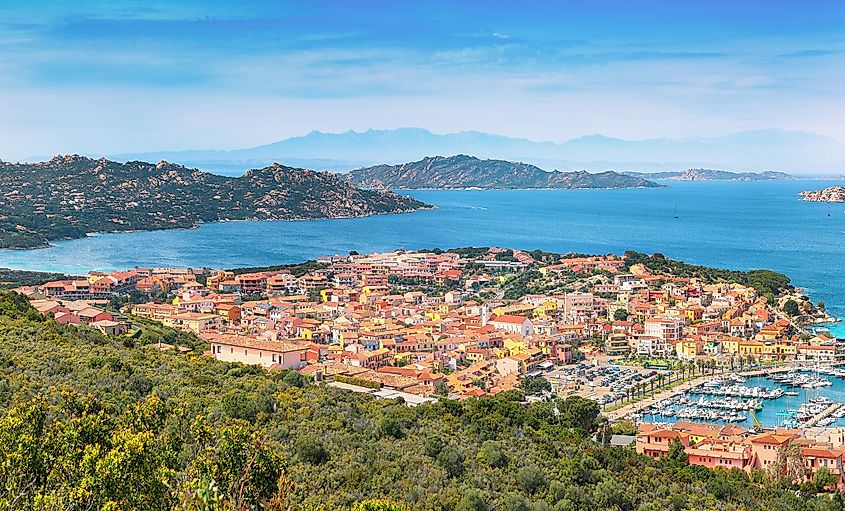
The 10 Hottest Countries In The World
It can get pretty toasty out there, especially in some regions of the globe. These ten countries consistently push the mercury readings to uncomfortable (for most) levels. The following figures were calculated by taking the collective average of the annual temperatures between 1991 and 2020.
- Mali (28.83°C / 83.89°F)
- Burkina Faso (28.71°C / 83.68°F)
- Senegal (28.65°C / 83.57°F)
- Tuvalu (28.45°C / 83.21°F)
- Djibouti (28.38°C / 83.08°F)
- Mauritania (28.34°C / 83.01°F)
- Bahrain (28.23°C / 82.81°F)
- Palau (28.04°C / 82.47°F)
- Qatar (28.02°C / 82.44°F)
- The Gambia (27.97°C / 82.35°F)
1. Mali (28.83°C / 83.89°F)

The Republic of Mali is a sizzling hot, landlocked nation in Northwestern Africa. The landscape is primarily a blend of the arid Sahara and the semi-arid Sahel regions, with the Niger River flowing for just over 1,000 miles (1,600 km) through the interior, providing fertile soils in an otherwise challenging environment. Most of Mali receives scarce rainfall and hence, suffers from frequent droughts. The northern part of Mali experiences a hot desert climate with scorching summers, while the central part has a hot semi-arid climate with an intense hot season and a brief, rainy season. Temperatures in the north can be as high as 48°C (118.4°F) in some areas. The southern part has a comparatively milder climate with defined dry and wet seasons but with high temperatures throughout the year.
2. Burkina Faso (28.71°C / 83.68°F)

Just South of Mali is Burkina Faso, a country that sits on a vast savanna plateau. Given the proximity, Burkina Faso experiences an extremely similar year-round temperature average to its Northern neighbor, though the seasons and environment manifest in distinct ways. The country experiences two distinct seasons, the dry and the wet, and three temperature zones. Hot, dry winds called harmattan blow in the dry season, making the heat often unbearable. The rainy season lasts from May to September, with rainfall volume greatly varying from south to north of the country. The northern Sahel receives less than 600 mm of annual rainfall, while the Sudan-Guinea zone in the south receives over 900 m of yearly rain. The Sudan-Sahel zone between these two receives an intermediate volume of rainfall. Average annual temperatures also become lower from north to south.
3. Senegal (28.65°C / 83.57°F)

The party continues West of Mali, in the Republic of Senegal. Though the Atlantic Ocean embraces its Western border, little respite is offered from the scorching average temperatures. But despite the heat, humans have learned to cope and even thrive here since the Paleolithic era (Senegal is one of only a handful of countries with such evidence dating back this far). From May to November, the climate is humid and rainy (and hot), while the dry season is from December to April (and is also hot!). Temperatures are milder along the coast than in the interior. Temperatures as high as 54 °C (129.2 °F) have been recorded in the Tambacounda region in the country's interior.
4. Tuvalu (28.45°C / 83.21°F)

The nation of Tuvalu is made up of a collection of nine idyllic islands (coral atolls) in the Polynesian subregion of Oceania, roughly equidistant from Hawaii and Australia. As one might expect, the climate is tropical, with heavy rains arriving between November and March. High temperatures prevail all year round, ranging from 25°C to 30°C/77°F to 86°F. The country also experiences powerful cyclones during the tropical cyclone season of November to April.
5. Djibouti (28.38°C / 83.08°F)

The Republic of Djibouti is a small East African nation encompassed by Southern Eritrea and the Red Sea (to the North), Eastern Ethiopia (to the West), Northwestern Somalia (to the Southeast), and the Gulf of Aden (to the East). This region experiences a hot, arid, subtropical climate with little seasonal variation. High temperatures prevail all year round with a mean daily maximum range of 32 to 41 °C (90 to 106 °F). In eastern Djibouti, the most significant temperature gradients are found, with highlands experiencing nearly freezing temperatures in winter and the littoral plains having temperatures of over 41 °C (106 °F) in summer. Making matters more challenging is the fact that Djibouti is incredibly freshwater-scarce (only 0.3 km3 of renewable sources). Along with being one of the world's hottest/driest countries, Djibouti is also home to one of the lowest places on the planet (these phenomena tend to correlate), Lake Assal, which sits at 155 meters/509 feet below sea level.
6. Mauritania (28.34°C / 83.01°F)

The Islamic Republic of Mauritania rests North of Senegal and North/West of Mali (as well as South of Western Sahara). Given that 90% of its land falls within the Sahara Desert, life here can be a rather hot, dusty, and arid affair. Naturally, most of the population has gravitated to the Atlantic Coast, and in particular, the capital city of Nouakchott. Extremes of temperature are experienced in Mauritania, with a long, dry season and scanty and irregular rainfall in the short wet season. Diurnal variations in temperature in desert areas can be extreme. In the country's Saharan zone, temperatures can range from as low as the freezing point in the early morning to as high as 38 °C (100.4 °F) mid-afternoon in December and January. In June, maximum temperatures can easily be above 49 °C (120.2 °F) by the afternoon. Except for the narrow coastal region that is under the influence of oceanic trade winds, dry, hot winds called harmattan blow across much of the country during the dry season. Along with its oppressive climate, Mauritania has also experienced a spicy past – just recently breaking free of a long stretch of political conflicts and legitimized slavery, but is now seen as an emerging democratic nation.
7. Bahrain (28.23°C / 82.81°F)

Situated in the Persian Gulf and sandwiched between Saudi Arabia (to the West) and Qatar (to the East), the small archipelagic Middle East nation of Bahrain does its best to keep cool. The Kingdom of Bahrain (officially) does enjoy mild winters, but in the summertime, things tend to get exceptionally hot and humid. The country experiences an arid climate, with average afternoon summer temperatures being as high as 40 °C (104 °F). Desertification, droughts, and dust storms all pose additional environmental challenges. Warm, dry winds called qaws blow in the summer, often bringing sand clouds. Bahrain also receives very little rainfall, with most rain falling in the winter months as brief, torrential downpours. Thus, the country lacks any permanent rivers or streams.
8. Palau (28.04°C / 82.47°F)

The Republic of Palau is a cluster of hundreds of gorgeous limestone and volcanic islands in the North Pacific Ocean, east of the southern Philippines. Given its chart-topping average temperatures, vulnerability to rising sea levels, and captivating natural beauty, Palau is a global leader in combating climate change and establishing environmental protocols. The country experiences a tropical rainforest climate with heavy rains all year round. The high humidity and temperatures often combine to create uncomfortable conditions, but that is no deterrent to tourists who are still attracted by the country's spectacular natural beauty.
9. Qatar (28.02°C / 82.44°F)

The recent host of the 2022 FIFA World Cup had to build air-conditioned stadiums to keep the best soccer players from across the globe from sweating up a storm. The State of Qatar (officially) occupies the Qatar Peninsula, thereby sharing its sole land border with Saudi Arabia (to the South). It is also separated from Bahrain by the narrow Gulf of Bahrain and otherwise is completely embraced by the Persian Gulf. Desert covers most of Qatar, and the country experiences scorching, sunny summers and very mild winters.
10. The Gambia (27.97°C / 82.35°F)

Just dipping below that 28-degree Celsius average threshold is the Republic of Gambia, the smallest nation in mainland Africa. Its slim footprint extends East into the Southern portion of Senegal from the Atlantic Ocean, hugging the floodplain of the Gambia River – one of the continent's major waterways. The country experiences a sub-tropical climate with two distinct seasons - the long, dry season, and a short, wet one, with high temperatures throughout the year. The Gambia therefore experiences a similar climate to its surrounding neighbor, though the relatively large percentage of water makes for grassy terrain.
Out of the frying pan and into the fire. These sizzling countries have posted intimidating weather reports over the last thirty years. Climate change has made life more difficult for the people of these places by making the climate more extreme. While droughts and desertification are a cause of concern for the African and Middle Eastern nations on this list, the Pacific islands are threatened by rising sea levels and extreme weather events. Thus, the future of these hottest countries is at stake, and we are to blame for that.
The 10 Hottest Countries in the World
| Rank | Country | Average Yearly Temperature (°C) | Average Yearly Temperature (°F) | Region |
|---|---|---|---|---|
| 1 | Mali | 28.83 | 83.89 | West Africa |
| 2 | Burkina Faso | 28.71 | 83.68 | West Africa |
| 3 | Senegal | 28.65 | 83.57 | West Africa |
| 4 | Tuvalu | 28.45 | 83.21 | Oceania |
| 5 | Djibouti | 28.38 | 83.08 | East Africa |
| 6 | Mauritania | 28.34 | 83.01 | Northwest Africa |
| 7 | Bahrain | 28.23 | 82.81 | Western Asia/Middle East |
| 8 | Palau | 28.04 | 82.47 | Oceania |
| 9 | Qatar | 28.02 | 82.44 | Western Asia/Middle East |
| 10 | The Gambia | 27.97 | 82.35 | West Africa |







